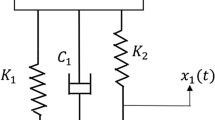Abstract
This paper studies the tuning process of controllers for fully actuated manipulators. To this end, we propose a methodology to design the desired damping matrix—alternatively, the derivative gain of a PD controller—of the closed-loop system such that n second-order systems can approximate its behavior with a prescribed damping coefficient, where n denotes the degrees of freedom of the system. The proposed approach is based on the linearization of the closed-loop system around the desired configuration and is suitable for different control approaches, such as PD control plus gravity compensation, impedance control, and passivity-based control. Furthermore, we extensively analyze simulations and experimental results in a cobot.
T. Coleman and G. Franzese: Equal contribution authorship.
Access this chapter
Tax calculation will be finalised at checkout
Purchases are for personal use only
Similar content being viewed by others
Notes
- 1.
The matrix \(\phi _\texttt{n}\) can be obtained via Cholesky decomposition or singular value decomposition. For further details, we refer the reader to [5].
- 2.
- 3.
Namely, \(K = \frac{1}{4}K_\texttt{d}\).
- 4.
The code to implement the proposed controller in the Panda robot is available at https://github.com/franzesegiovanni/franka_damping_design.
- 5.
References
Albu-Schäffer, A., et al.: Cartesian impedance control of redundant robots: recent results with the DLR-light-weight-arms. In: 2003 IEEE International Conference on Robotics and Automation, vol. 3, pp. 3704–3709 (2003)
Albu-Schäffer, A., et al.: The DLR lightweight robot: design and control concepts for robots in human environments. Ind. Robot: Int. J. (2007)
Franzese, G., et al.: ILoSA: interactive learning of stiffness and attractors. In: 2021 IEEE/RSJ International Conference on Intelligent Robots and Systems (IROS), pp. 7778–7785. IEEE (2021)
Gaz, C., et al.: Dynamic identification of the Franka Emika panda robot with retrieval of feasible parameters using penalty-based optimization. IEEE Robot. Autom. Lett. 4(4), 4147–4154 (2019)
Horn, R.A., Johnson, C.R.: Matrix Analysis. Cambridge University Press (2012)
Khalil, H.K.: Nonlinear Systems, 3rd edn. Prentice-Hall, New Jersey (2002)
Marcus, M., Minc, H.: A Survey of Matrix Theory and Matrix Inequalities, vol. 14. Courier Corporation (1992)
Peternel, L., et al.: Teaching robots to cooperate with humans in dynamic manipulation tasks based on multi-modal human-in-the-loop approach. Autonomous Robot. 36(1), 123–136 (2014)
Prendergast, J.M., et al.: Biomechanics aware collaborative robot system for delivery of safe physical therapy in shoulder rehabilitation. IEEE Robot. Autom. Lett. 6(4), 7177–7184 (2021)
van der Schaft, A.J., Jeltsema, D.: Port-Hamiltonian systems theory: an introductory overview. Foundations Trends Syst. Control 1(2–3), 173–378 (2014)
Wesselink, T.C., Borja, P., Scherpen, J.M.A.: Saturated control without velocity measurements for planar robots with flexible joints. In: 2019 IEEE 58th Conference on Decision and Control (CDC), pp. 7093–7098. IEEE (2019)
Acknowledgments
The authors thank Cosimo Della Santina for the fruitful discussions during the elaboration of this manuscript.
Tomás Coleman’s research is funded by the Netherlands Organization for Scientific Research project Cognitive Robots for Flexible Agro-Food Technology, grant P17-01.
Giovanni Franzese’s research is funded by the European Research Council Starting Grant Teaching Robots Interactively (TERI), project reference 804907.
Author information
Authors and Affiliations
Corresponding author
Editor information
Editors and Affiliations
Rights and permissions
Copyright information
© 2023 The Author(s), under exclusive license to Springer Nature Switzerland AG
About this paper
Cite this paper
Coleman, T., Franzese, G., Borja, P. (2023). Damping Design for Robot Manipulators. In: Borja, P., Della Santina, C., Peternel, L., Torta, E. (eds) Human-Friendly Robotics 2022. HFR 2022. Springer Proceedings in Advanced Robotics, vol 26. Springer, Cham. https://doi.org/10.1007/978-3-031-22731-8_6
Download citation
DOI: https://doi.org/10.1007/978-3-031-22731-8_6
Published:
Publisher Name: Springer, Cham
Print ISBN: 978-3-031-22730-1
Online ISBN: 978-3-031-22731-8
eBook Packages: Intelligent Technologies and RoboticsIntelligent Technologies and Robotics (R0)




